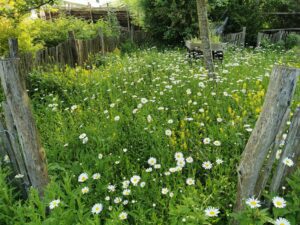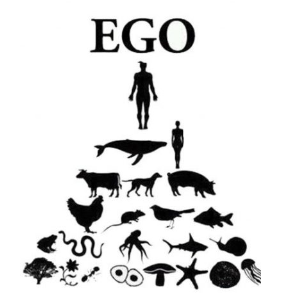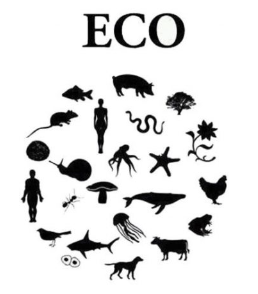
In our B&B, we regularly receive guests who ask with interest about our bio-ecological construction. Then I also usually talk about our ecological garden.
“So what exactly is an ecological garden?” asked one of our guests. At first I thought: surely that’s a simple question. We don’t use pesticides, haven’t paved much and more of those common answers. But actually it goes a lot further. It’s about how you look at a garden, what you expect from it.
Egological gardens

Egological gardens are 100% designed to satisfy man and our ego. Beautiful, large, green lawns, clean lines, flat as a billiard table, regularly fertilized, frequently trimmed, preferably even with a robot. You can play golf, Kubb, pitch a tent, … In the borders are beautiful flowers and shrubs. Flowers that we, as humans, find beautiful. Beautiful usually also means: special, unique, not easily found elsewhere. Exotic and cultivated flowers and plants fit in perfectly. Weeds should be avoided by lots of weeding or even easier by using herbicides. A mole ruins our ideal garden. An extreme example of such an egological garden reads, “Artificial grass is green, isn’t it?”
Ecological gardens

Ecological gardens put nature first. Man is only a part of that nature. To speak of a nature-rich garden, there must be a lot of attention to local and native plants and animals. Or better, let nature find its own way and let plants emerge that in an Egological garden would be seen as weeds. Actually, management for humans is much easier in such a garden and so one speaks of the lazy gardener. It is usually limited to giving nature a helping hand by scorching soils, removing exotics and keeping weeds in check. Tight grasses may be there, but are kept to a minimum.
In many cases, a garden full of flowers seems to be an ecological garden. But …
We let a lot of wild plants grow and bloom in our garden. Knotweed, thistles, jacobweed and wildflowers are abundant, We also have planted and purchased flowers such as sunflowers and rudbeckias. The difference ? on the wild plants there is a sea of life: buzzing, sucking, flying, sniffing, spreading, pollinating. On the purchased material, at most half of it can be observed. Recently, goldfinches enjoyed our buttonwings.
The same goes for our ecological pond. It was built with minimal impact on the environment: no concrete construction, just EPDM to keep the water level, purified by a reed bed. We swim in it regularly! But most of all, we enjoy the nature it attracts: frogs, salamanders, dragonflies, damselflies, skaters. And our big favorite: the kingfisher. But also the blue heron, cormorant, moorhen, coot, …. I leave to you the comparison with a chlorinated pool.
Are you an egological or an ecological gardener ?
- Do you ever let weeds grow ?
- Are you participating in mow may not ?
- Let the mole find its home and put a flower on the molehills ?
- Do you provide holes in the fence so hedgehogs can pass by ?
- Do you sometimes let a deer enjoy some of your tasty garden ?
- Do you not use herbicides and pesticides ?
- Do you not spray or very exceptionally ?
Which garden do you have ? You can put these 2 fundamentally different ways of gardening on a scale and look at them as the extremes of a continuum. Most gardens will be somewhere in between. But unfortunately, most gardens do sit on the side of the egological.
Recently, the European law on nature restoration came into force. Will you do your part and turn your garden into an ecological opulence ?